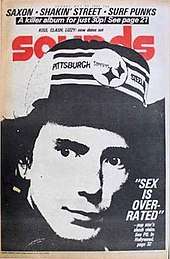Sounds (magazine)
Sounds was a UK weekly pop/rock music newspaper, published from 10 October 1970 to 6 April 1991. It was produced by Spotlight Publications (part of Morgan Grampian), which was set up by Jack Hutton and Peter Wilkinson, who left Melody Maker to start their own company. Sounds was their first project, a weekly paper devoted to progressive rock and described by Hutton, to those he was attempting to recruit from his former publication, as "a leftwing Melody Maker". Sounds was intended to be a weekly rival to titles such as Melody Maker and New Musical Express (NME). It was well known for giving away posters in the centre of the paper (initially black and white, but colour from late 1971) and later for covering heavy metal (especially the new wave of British heavy metal (NWOBHM))[1] and Oi! music in its late 1970s–early 1980s heyday.[2]
 Cover of Sounds (24 May 1980) | |
| Categories | Music newspaper |
|---|---|
| Frequency | Weekly |
| First issue | 10 October 1970 |
| Final issue | 6 April 1991 |
| Company | United Newspapers |
| Country | United Kingdom |
| Based in | London |
| Language | English |
Sounds was one of the first music papers to cover punk. Mick Middles covered the Manchester music scene for Sounds from 1978 to 1982 writing about many of the up and coming bands of the time from Buzzcocks and Slaughter & The Dogs to The Fall (band) and Joy Division.[3] John Robb (musician) joined in 1987 and came up with the term "Britpop". The paper's editors realised the importance of its regional audience and had freelancers across the UK contributing gig reviews and articles about up-and-coming local bands.
Keith Cameron wrote about Nirvana after Robb carried out the first ever interview with them.[4] Frontman Kurt Cobain was often seen wearing a Sounds shirt.
One of the trinity of British music weeklies, along with NME and Melody Maker, Sounds folded in 1991 after the parent company, United Newspapers, sold all their music titles to EMAP Metro. Morgan-Grampian had been acquired by United Business Media – then known as United News and Media – in 1987, first as part of the United Advertising Publications (UAP) division and later as part of the then CMP Information portfolio. A legacy of Sounds was the creation of the heavy metal/rock magazine Kerrang!, which was originally issued as a supplement before being spun off as a separate publication.[1]
Contributors included Garry Bushell, Mick Middles, Geoff Barton, John Robb, Mick Sinclair,[5] Caroline Coon, Antonella Gambotto, Vivien Goldman, Jonh Ingham, Alan Moore (a.k.a. "Curt Vile"),[6] Lizo Mzimba,[7] John Peel, Barbara Charone, Edwin Pouncey (a.k.a. "Savage Pencil"), Cathi Unsworth, Jon Ronson, Jon Savage, Sylvie Simmons, Penny Valentine, Marguerite Van Cook, Mary Anne Hobbs, Mat Snow, Johnny Waller, James Brown (who went on to form Loaded), Andy Ross (who wrote as "Andy Hurt" and went on to form Food Records), Steve Lamacq, Kev F. Sutherland and Russ Carvell's UT strip, and photographers Andy Phillips, Virginia Turbett, Tony Mottram, Ross Halfin and Janette Beckman.[8]
See also
References
- Tucker, John (2006). "Denim and Leather – 1979". Suzie Smiles... The New Wave of British Heavy Metal. Church Stretton, Shropshire, UK: Independent Music Press. pp. 22–23. ISBN 978-0-9549704-7-5.
Sounds (...) produced more and more features as the editorial staff realised that metal was one of the main reasons the paper sold
- "Cockney Rejects: History and Pictures / Oi Music / Punk Rock". Punkmodpop.free.fr. Archived from the original on 28 August 2009. Retrieved 24 March 2010.
- Middles, Mick. "Rock's Back Pages: Mick Middles". Retrieved 13 January 2019.
- Robb, John (25 October 2009). "Classic Interview: Nirvana 1989". Clash. Clashmusic.com. Retrieved 24 March 2011.
- "The Mick Sinclair Archive". Retrieved 20 March 2013.
- "The Sounds Collection". The Alan Moore Store. 4colorheroes.com. Archived from the original on 7 July 2011. Retrieved 24 March 2011.
- Display Ad AwakeningsThe Observer; 17 March 1991
- "ACAPULCO GOLD INTERVIEW: JANETTE BECKMAN". Archived from the original on 7 January 2008. Retrieved 9 January 2008.
External links
| Wikiquote has quotations related to: Sounds (magazine) |
- Comic strips that were published in Sounds by Alan Moore
- Reviews and features published in Sounds by Mick Sinclair
- Photos published in Sounds by Simon Clegg